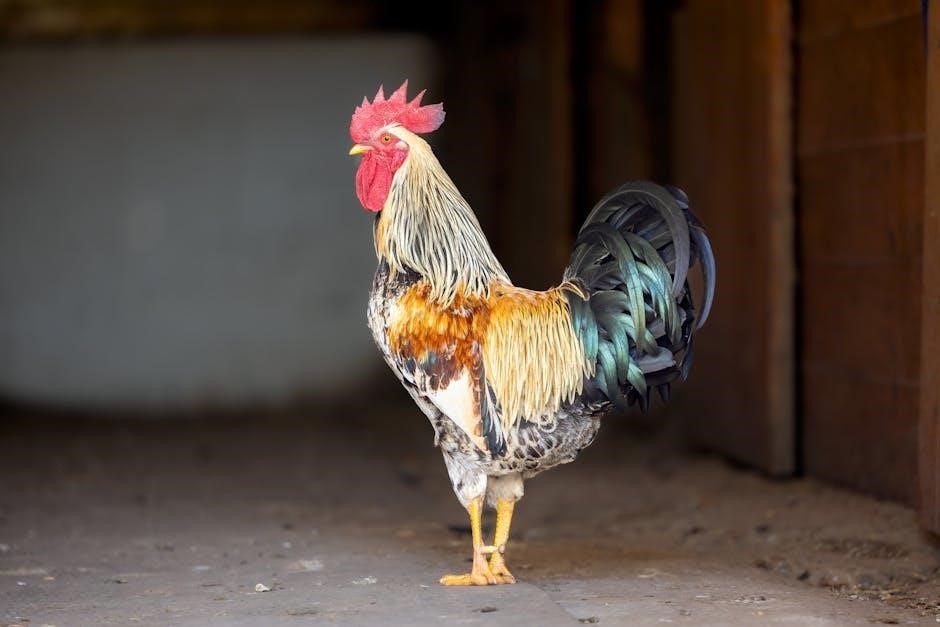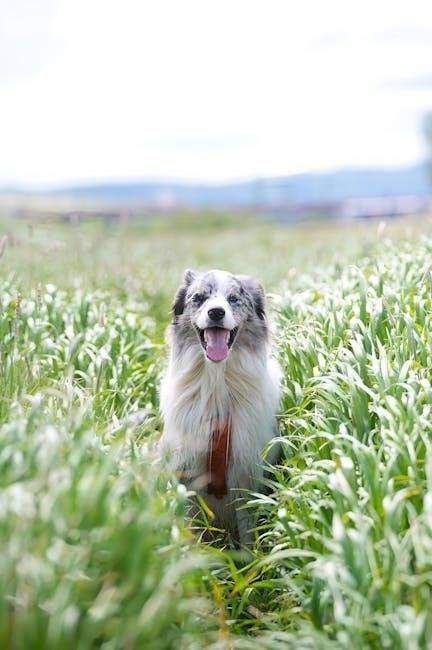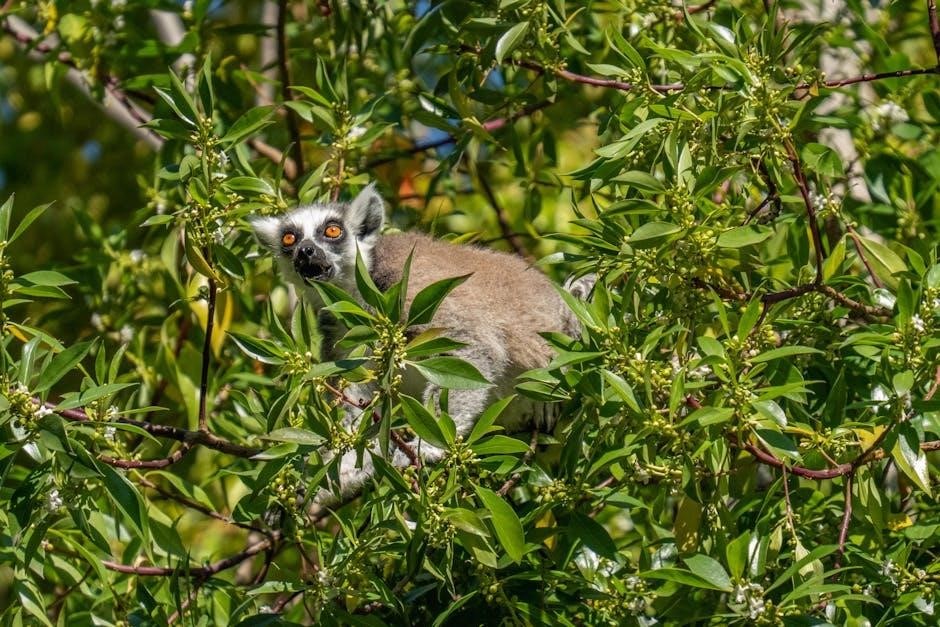Earn the Cadette Animal Helpers Badge by exploring the human-animal connection, learning how animals assist humans, and advocating for their welfare. Discover the impact of service animals and how to support animals in your community through structured steps and meaningful actions.
Overview of the Badge and Its Importance
The Cadette Animal Helpers Badge is designed to foster empathy, responsibility, and understanding of the vital role animals play in human life. By earning this badge, participants gain insights into how animals contribute to human well-being, from service animals to emotional support. The badge emphasizes the importance of animal welfare, encouraging girls to become advocates and take action in their communities. It promotes a deeper appreciation for the human-animal bond and equips participants with the knowledge and skills to make a positive impact. This badge is not just an educational achievement but a call to action for compassionate leadership and environmental stewardship.
Why Animals Are Essential to Human Life and Well-being
Animals play a vital role in human life, providing companionship, emotional support, and physical assistance. They have been human partners for centuries, aiding in tasks like farming, transportation, and hunting. Service animals, such as guide dogs and therapy animals, enhance the quality of life for individuals with disabilities. Animals also contribute to mental health by reducing stress and loneliness. Their presence fosters empathy, responsibility, and a sense of connection. By understanding and appreciating these contributions, we can better advocate for their welfare and strengthen the bond between humans and animals, ensuring their well-being for future generations.

Understanding the Human-Animal Connection
The bond between humans and animals has existed for over 15,000 years, evolving from survival partnerships to emotional and therapeutic connections, highlighting their essential role in our lives.
Historical Perspectives on Human-Animal Relationships
The bond between humans and animals dates back over 15,000 years, starting with animals aiding in tasks like farming and protection. Early humans relied on animals for survival, fostering a deep connection. Over time, this relationship evolved, with animals becoming companions and emotional supporters. Historical records show humans transitioning from viewing animals as tools to valuing them as partners. This shift highlights the enduring importance of animals in human life, from ancient times to modern-day service animals. Understanding this history is key to earning the Cadette Animal Helpers Badge, as it emphasizes the significance of animals in human well-being and societal development.
Modern-Day Bonds Between Humans and Animals

In today’s world, the human-animal bond is stronger than ever, with animals serving as companions, service providers, and emotional supporters. Modern roles include therapy animals, search and rescue teams, and service animals assisting individuals with disabilities. These relationships highlight the mutual benefits of trust, loyalty, and affection. The Cadette Animal Helpers Badge emphasizes understanding and strengthening these connections. By exploring how animals contribute to human well-being, participants can advocate for animal welfare and build compassionate communities. This badge encourages girls to appreciate the diverse ways animals enhance human lives, fostering a deeper appreciation for these vital relationships.

Requirements for Earning the Animal Helpers Badge
Earn the badge by completing five steps: explore the human-animal connection, learn how animals help humans, understand service animals, advocate for welfare, and take community action;
Step 1: Explore the Connection Between Humans and Animals
This first step focuses on understanding the historical and modern bonds between humans and animals. Research how human views on animals have evolved over centuries, from seeing them as mere resources to recognizing their roles as companions and helpers. Explore how animals have assisted with tasks like farming, hunting, and protection, and how this relationship has deepened into emotional connections. Additionally, consider watching documentaries or reading materials that highlight the transformation of human-animal relationships, providing insights into their shared history and mutual benefits.
Step 2: Learn How Animals Help Humans in Various Ways
Discover the diverse ways animals contribute to human life, from service and therapy roles to farming and conservation. Service animals assist individuals with disabilities, while therapy animals provide emotional support. Animals also play crucial roles in agriculture, aiding in tasks like herding and pest control. Additionally, they contribute to environmental conservation by maintaining ecosystems. Research these roles to understand the depth of their impact. This step encourages you to explore real-life examples and the training processes behind these helpful animals, fostering appreciation for their contributions to society and individual well-being. Learning about these roles will deepen your understanding of human-animal interdependence.
Step 3: Understand the Role of Service Animals
Service animals are specially trained to assist individuals with disabilities, performing tasks that improve their quality of life. From guiding the visually impaired to alerting the hearing-impaired, these animals are invaluable. They also support those with mobility issues, epilepsy, or mental health conditions. Service animals are protected under laws ensuring their access to public spaces. Learning about their training, responsibilities, and the legal rights they hold is crucial. This step helps you appreciate the dedication and impact of these animals, deepening your understanding of their critical role in human well-being and independence. Their work highlights the profound bond between humans and animals in service.
Step 4: Advocate for Animal Welfare and Protection
Advocating for animal welfare involves championing the rights and well-being of animals. This step encourages you to raise awareness about issues like animal cruelty, habitat loss, and neglect. Learn about laws and organizations that protect animals and how you can support them. Educate others about the importance of ethical treatment and responsible pet ownership. You can also participate in campaigns, sign petitions, or volunteer with animal shelters. By advocating, you help create a safer, more compassionate world for animals. This step empowers you to make a difference and inspire others to join the cause of protecting and caring for animals. Your voice matters in their lives.
Step 5: Take Action to Help Animals in Your Community
Taking action to help animals in your community is a hands-on way to demonstrate your commitment to their well-being. This step encourages you to identify local needs and contribute meaningfully. Volunteer at animal shelters, assist with pet adoption events, or organize fundraising campaigns to support animal welfare organizations. You can also participate in clean-up initiatives for wildlife habitats or start a pet supply drive. Educating others about animal care and fostering pets are additional ways to make a difference. By taking action, you not only improve the lives of animals but also inspire others to join in making a positive impact. Your efforts can lead to lasting change in your community and beyond.

Additional Resources and Materials
Access the Cadette Animal Helpers Badge PDF guide, documentaries, and activity sheets for comprehensive learning. Utilize these resources to deepen your understanding and complete badge requirements effectively.
Downloading the Cadette Animal Helpers Badge PDF Guide
The Cadette Animal Helpers Badge PDF guide is a comprehensive resource outlining requirements and activities. It includes detailed steps, educational content, and interactive exercises to help Girl Scouts earn the badge. The guide emphasizes understanding the human-animal connection, the roles of service animals, and advocating for animal welfare. By downloading the PDF, participants gain access to structured lesson plans and creative ideas to engage with animals in their community; This resource is essential for a fulfilling and educational experience, ensuring a thorough understanding of how to support and protect animals effectively.
Recommended Documentaries and Research Materials
To deepen your understanding of animal helpers, explore documentaries and research materials that highlight the human-animal connection. These resources offer insights into how animals have historically supported humans, from farming to service roles. Documentaries showcase the evolution of service animals and their modern-day applications in therapy and assistance. Research materials provide in-depth studies on animal behavior and welfare, enhancing your knowledge for the badge requirements. These resources are invaluable for creating engaging presentations or community projects, ensuring a well-rounded understanding of how animals contribute to human well-being and society. They complement the PDF guide, offering a visual and educational enrichment to your journey as an animal helper.

Becoming an Animal Advocate
Become an animal advocate by promoting animal welfare, educating your community, and taking action to protect animals. These efforts align with the badge requirements and foster meaningful change.
Ways to Promote Animal Welfare in Your Community
Empower your community to support animal welfare by organizing workshops, collaborating with local shelters, and creating educational materials. Share stories of human-animal bonds to inspire others. Partner with schools to integrate animal kindness into curricula. Volunteer at adoption events or fundraisers to help animals in need. Advocate for pet-friendly policies in public spaces. Educate neighbors about responsible pet ownership and the importance of spaying/neutering. Organize clean-up drives for animal habitats or start a pet supply donation campaign. By taking these steps, you can create a compassionate environment where animals thrive, aligning with the badge’s mission to foster meaningful connections and support.
How to Educate Others About Animal Helpers
Educate others about animal helpers by sharing stories of their roles in assisting humans, such as service animals and therapy pets. Create engaging presentations or workshops to highlight how animals contribute to society. Use social media platforms to spread awareness about animal welfare and the importance of kindness toward animals. Develop educational materials, like brochures or videos, to distribute in schools or community centers. Encourage others to participate in animal-related activities, such as volunteering at shelters or adopting pets. By fostering empathy and understanding, you can inspire others to appreciate and support animal helpers, creating a ripple effect of compassion in your community. This aligns with the badge’s goal of promoting animal advocacy and education.
Earning the Cadette Animal Helpers Badge empowers girls to understand the vital role animals play in human lives, fostering compassion and advocacy for animal welfare and conservation.
The Impact of Earning the Animal Helpers Badge
Earning the Animal Helpers Badge creates a lasting impact by fostering empathy, responsibility, and advocacy for animals. Girls gain a deeper understanding of how animals enrich human lives, from service animals to companions. By completing the requirements, they develop essential life skills, such as compassion and leadership, while contributing to their communities. This badge inspires a lifelong commitment to animal welfare, encouraging girls to become active advocates and educators. The knowledge and experiences gained empower them to make a positive difference, promoting kindness and stewardship for animals and the environment. The badge serves as a meaningful achievement, celebrating their dedication to helping others—both human and animal alike.

Continuing Your Journey as an Animal Helper
Earning the Animal Helpers Badge is just the beginning of your journey as an advocate for animals. You can continue making a difference by volunteering at shelters, supporting conservation efforts, or advocating for animal-friendly policies. Share your knowledge with others to inspire them to take action. Consider mentoring younger scouts or starting a community project focused on animal welfare. Remember, every small effort contributes to a larger impact. Stay committed to the values of compassion and stewardship, and explore further opportunities to help animals, whether through career paths or lifelong hobbies. Your dedication can inspire others to join the cause, creating a ripple effect of kindness and care.
